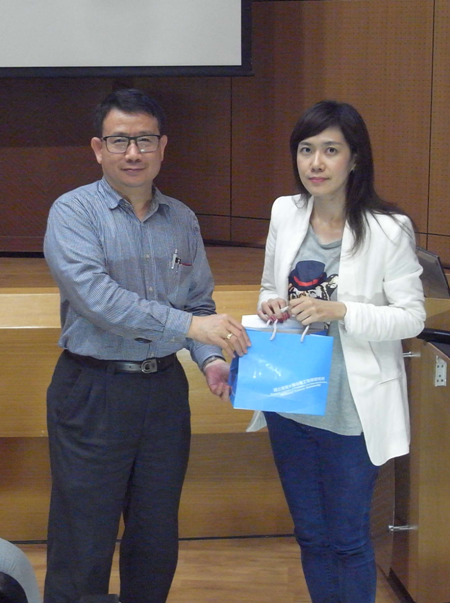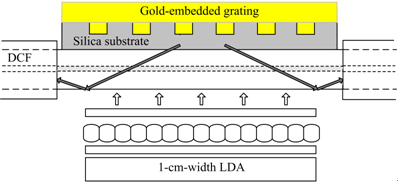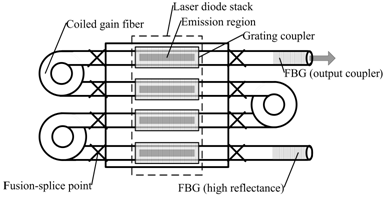 |
|
 |
| |
发行人:林清富所长 编辑委员:陈奕君教授 主编:林筱文 发行日期:2013.05.15 |
| |
|
|
 |
 本所蔡振水教授荣获「IEEE UFFC-S Achievement Award 2013」,特此恭贺!
本所蔡振水教授荣获「IEEE UFFC-S Achievement Award 2013」,特此恭贺!
 本所孙启光教授荣获「2013潘文渊文教基金会研究杰出奖」,特此恭贺!
本所孙启光教授荣获「2013潘文渊文教基金会研究杰出奖」,特此恭贺!
 本所博士生洪士哲、王榆文同学参与本院电资队荣获「台大杯桌球赛青年组冠军」,特此恭贺!
本所博士生洪士哲、王榆文同学参与本院电资队荣获「台大杯桌球赛青年组冠军」,特此恭贺!
本所5月份演讲公告:
|
日期
|
讲者简介 |
讲题 |
地点 |
时间 |
|
光电论坛
|
|
5/17
(Fri) |
边历峰教授
中国科学院苏州纳米技术与纳米仿生研究所 |
中国科学院纳米器件与应用重点实验室介绍 |
明达馆205室 |
15:30-17:30 |
徐科教授
中国科学院苏州纳米技术与纳米仿生研究所 |
HVPE growth of bulk GaN: stress,
threading dislocation, and intrinsic
properties of high-quality GaN |
|
5/24
(Fri) |
陈信吉副处长
TSMC |
待订 |
博理馆
101演讲厅 |
15:30-17:30 |
|
|
|
|
 |
|
 |
|
| |
|
|
 |
|
4月份「光电论坛」演讲花絮(花絮整理:姚力琪) |
|
时间: |
2013年4月26日(星期五)下午3点30分 |
|
讲者: |
陈慧如小姐(编剧、作家) |
|
讲题: |
我的写作人生 |
|
|
陈慧如小姐于4月26日(星期五)莅临本所访问,并于博理馆101演讲厅发表演说。陈慧如小姐毕业于芝加哥大学社会科学硕士班,主修性别与文化认同研究。曾任商业周刊alive资深记者、MOOK旅游书资深采访编辑。现为编剧及作家,作品:电视剧&电影《痞子英雄》、电影《犀利人妻最终回》、电视剧《流氓蛋糕店》、电影《听不见 我爱你》(获2013年度优良剧本奖佳作)。
本次演讲内容主要为分享个人成长经历及过程。本所教师及学生皆热烈参与演讲活动,演说内容丰富精彩,与现场同学互动佳,本所师生皆获益良多。 |
| |

陈慧如小姐(右)与本场演讲主持人林清富所长(左)合影。
|
|
| |
|
 |
|
 |
|
| |
|
|
 |
Transient Behaviors of Current-injection Quantum-dot Microdisk Lasers
Professor Ming-Hua Mao's
Laboratory
Graduate Institute of Photonics and
Optoelectronics, National Taiwan University
台湾大学光电所 毛明华教授
We studied the transient behaviors of current-injection quantum-dot microdisk lasers at room temperature. Unique optical responses were observed, including the suppression of relaxation oscillations and fast turn-on. With the help of rate-equation modeling, the suppressed relaxation oscillations are attributed to the enhanced spontaneous emission factor in microdisk lasers. Short turn-on time, around 1 ns without pre-bias, results from the reduced carrier lifetime caused by the Purcell effect and increased nonradiative recombination rate due to higher surface/volume ratio. With short turn-on time, a large-signal direct modulation experiment at 1 Gbps is demonstrated. Modal transient behavior was also investigated under various temperatures from 100 to 300 K. Both of the transient lasing and steady state lasing from side modes are suppressed at temperatures higher than 250K. Therefore, the quantum-dot microdisk lasers show the potential of single-mode operation under high-speed modulation at room temperature. This work has been published in Opt. Express, Vol. 20, No. 3, pp. 3302, (2012).
|
 |
|
Fig. 1. The temporal optical responses measured from a QD microdisk laser. |
|
 |
|
Fig. 2. The ideal data stream at 1 Gbps, the real electric pulse shape, and the optical responses of the QD microdisk laser with pre-bias. |
|
 |
|
|
Enhancing LED Light Extraction by Optimizing Cavity and Waveguide Modes in Grating Structures
Professor Yih-Peng Chiou's
Laboratory
Graduate Institute of Photonics and
Optoelectronics, National Taiwan University
台湾大学光电所 邱奕鹏教授
We provided an optimization of light extraction efficiency (LEE) from light-emitting diodes (LEDs). The optimization is achieved when the structural parameters results in good cavity modes in both planar and grating structures, and also when the propagation direction of the fundamental waveguide mode is significantly converted to the direction normal to the grating surface by the gratings. In this research, we use two simple equations, one for cavity modes and the other for waveguide modes, to predict the loci of the optimal structural parameters of gratings. We first obtain the rules by analyzing simple planar structures as illustrate in Fig. 1. (a). Fig. 1. (b) shows the resonant condition by the micro-cavity effect. Fig. 1. (c) shows that the local maximum LEEs appear periodically and are close to the cross of the Fabry-Pérot resonances and the antinodes. The conditions of the resonance at normal incidence and the anitnodes for normal waves are marked by the thick red tics on the bottom and the thick black tics to the right, respectively. Even with the optimization, the LEE of typical planar of LED can only reach up to 30%. To realize ultra-high LEE LED, the source is designed to locate close to the middle of GaN cavity to concentrate the non-radiation power on the fundamental mode and a periodic dielectric wavelength-scaled structure is etched on the mesa surface of LEDs to convert the fundamental guided wave into air mode as schematized in Fig. 2. (a). We modified the resonant condition of normal incident case for grating-assisted system and gave the constructive interference of the emitted waves:

From Fig. 2. (b-c), the local maxima of LEE appear near the intersections of the two equations. The maximum LEE is close to 90% which is triple of that of the planar surface LEDs.
These results verified our prediction.
|
 |
|
Fig. 1. (a) Scheme of optical modes in in thin-film vertical LED. (b) Resonant condition by the micro-cavity effect. (c) Simulation results of LEE. Thick red tics represent the thickness with Fabry-Pérot resonance appearing at normal incidence, and thick black tics express as the antinode factors. |
|
 |
|
Fig. 2. (a) Propagation of waveguide modes in a grating structure. (b-c) Simulation results of the maximum LEE for grating depth versus the GaN
thickness for duty circle=0.3 and 0.5. |
Reference: W.-L. Yeh, C.-M. Fang, and Y.-P. Chiou, “Enhancing LED Light Extraction by Optimizing Cavity and Waveguide Mode in Grating Structures,” IEEE Journal of Display Technology, Vol. 9, No. 5, pp. 359-364, May, 2013.
|
|
| |
|
|
|
 |
|
| |
|
|
 |
论文题目:高指向性及高效率兆赫波光子发射器之开发
姓名:黄郁儒 指导教授:孙启光教授
| 摘要 |
|
本论文中,我们提出并实验证明两式依垛行开槽数组天线(rampart slot array antenna)为设计基础的兆赫波光子发射器(如图一、二a)。实验结果显示,我们不需使用任何高介电系数的聚焦媒介便可轻易得到高指向性的兆赫波辐射,在0.9兆赫的辐射场型中,不论在电场或磁场平面,其3dB束宽都可被有效地局限在30度辐射角以内。此外,结合接地共平面波导(grounded coplanar waveguide, GCPW)的新设计(如图二b),除了保有坚固基板的优点,组件辐射效率及高频操作更能被有效地提升。其原因在于能够储存散逸在电路表面及基板内的兆赫波并形成有效共振。此新设计亦有利于未来的大尺寸光电集成电路整合。
 |
 |
|
图一、依短路垛行开槽数组天线(short-circuited rampart slot
array antenna)为设计基础之兆赫波光子发射器。 |
图二、(a) 结合共平面波导(grounded coplanar
waveguide GCPW)及开路(open-circuited)垛行开槽数组天线之兆赫波光子发射器。(b)
共平面波导结构示意图。 |
|
论文题目:次波长光栅实现半导体激光数组侧向激发之高功率光纤激光
姓名:黄玠维 指导教授:黄升龙教授、黄鼎伟教授
| 摘要 |
|
当光纤激光的激发光源来到拥有更多发光区域之堆栈式激光数组(laser diode array, LDA),其在慢轴的多模态发光特性往往使得能被利用的功率受到限制,因此,本论文提出了一种更精巧且更有效率的光栅侧向式耦光架构,称为黄金镶嵌二氧化硅之光栅耦合器(gold-embedded silica grating coupler);利用此种特殊设计的光栅耦合器,可以直接将半导体激光数组及数组堆栈的光经由侧面耦合进双纤衣光纤(double-clad fiber, DCF)的内层纤衣,如图一所示。对于一维半导体激光数组之侧向耦光架构,实验结果显示黄金镶嵌二氧化硅之光栅耦合器能将42瓦,波长976 奈米的连续输出激光,耦合进直径400 微米之双纤衣光纤的内层纤衣中,耦光效率为50 %。更进一步,对于多维半导体激光数组堆栈(laser diode stack, LDS)侧向耦光架构,亦可藉由此光栅耦合器,提升整体耦光功率,同时实现了只使用单一一组半导体激光数组堆栈,即达成分布式侧向耦光光纤激光(distributed side-pumped fiber laser)之架构,如图二所示。当304.4瓦的半导体
激光数组堆栈输出,约124.6瓦的光可被耦合进入双纤衣光纤之内层纤衣,耦光效率为41 %。更进一步,产生出58瓦的光纤激光,斜率效率约为50 %,激光中心波长1090奈米,线宽约为0.11奈米,此窄线宽亦代表了此种分布式侧向激发激光的优势。最后,此种光栅侧向耦光技术不只能有效率地实现高功率且高质量的激光光源,同时光栅还能藉由奈米压印技术来大量生产以降低成本,十分具有商业竞争潜力。
 |
 |
|
图一、黄金镶嵌二氧化硅之光栅耦合器示意图 |
图二、单一半导体激光数组堆栈之分布式侧向耦光激光系统架构图 |
|
|
|
 |
|
 |
|
| |
|
|
 |
—
数据提供:影像显示科技知识平台 (DTKP, Display Technology
Knowledge Platform) —
—
整理:林晃岩教授、陈圣灏 —
生物显影:DVD也可以是个实验室
欧洲的科学家已经成功将商用的DVD传动装置转换成激光扫描显微镜可用于分析血液及达微米分辨率的细胞显影。Harisha Ramachandraiah 与瑞典斯德哥尔摩皇家技术学院(KTH Royal Institute of Technology)的团队,还有英国Plarion与挪威Lingvitae等公司,声称'lab-on-a-DVD'系统针对疾病提供经济实惠且方便的细胞诊断测试,例如针对人体免疫缺损病毒(HIV)。
这个方法主要在DVD传动装置与DVD媒体做了两个重要的改装。首先,在传动装置上加装额外的光电二极管来侦测通过盘片的穿透光与向前散射的光。其次,DVD媒体置换为抛弃式、多层的、半透明聚合物盘片,此盘片除了一般0.74
μm宽的螺旋轨道还包含了微流体通道(fluidic microchannels)。
进行实验之前,流体通道的内表面具有可让标的细胞与粒子附着于表面之功能。血液或其它有兴趣的液体样本注入信道,同时DVD传动装置被打开。附加的光电二极管会记录当盘片旋转时从半导体
激光发出的658 nm光所通过的量。如此所产生的结果是一张2维的图,被储存至计算机硬盘以供分析。细胞与粒子已成功地被束缚在处理过的通道里并呈现在结果的图片中。迄今,团队已经使用悬浮在溶液中不同大小的聚合物珠粒(1, 2.8 与 5 μm)测试系统,其中有CD4细胞(一种免疫细胞)为HIV病毒的重要指针。(注:若感染艾滋病毒会导致CD4细胞大幅下降。)
研究员现正努力地延展系统的功能以可以处理更大体积的样本使低浓度物种,如:循环肿瘤细胞可在完整整合的方法下被分析,此方法包含了通道表面修正,洗涤与样品准备的自动化。

|
|
图1、夹带光盘片的激光扫描显微镜系统(DVD-LSM)。(A)激光扫描显微镜系统的概观。硬件中包含了一具外部马达以控制旋转,一个热电偶用来控制温度及光电二极管数组用来测量光,整合至原型并透过个人计算机上的使用者接口来控制。透过个人计算机的软件做驱动并且经由USB传输数据。(B)激光扫描显微镜系统的原理:第二个光电检测器附加在一般的DVD装置纪录散射光的量或吸收收率,收集到的数据集合到图片档案中。 |
|
|
|
|
资料来源: |
Oliver Graydon, Bioimaging: Lab on a DVD, Nature Photonics 7, 267 (2013), Published online 27 March 2013, doi:10.1038/nphoton.2013.64
http://www.nature.com/nphoton/journal/v7/n4/full/nphoton.2013.64.html |
|
|
|
|
参考数据: |
Harisha Ramachandraiah, et al., Lab-on-DVD: standard DVD drives as a novel laser scanning microscope for image based point of care diagnostics, Lab Chip
13, 1578-1585, (2013),
doi:10.1039/C3LC41360H |
|
|
|
|
|
|
|
 |
|
 |
|
|
|
 |
|
 |
|